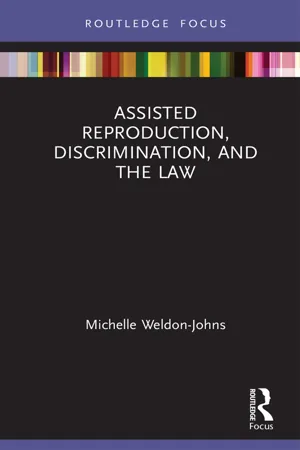
Assisted Reproduction, Discrimination, and the Law
Conceiving a New Interpretation of Equality
- 136 pages
- English
- ePUB (mobile friendly)
- Available on iOS & Android
Assisted Reproduction, Discrimination, and the Law
Conceiving a New Interpretation of Equality
About this book
The numbers of women undergoing Assisted Reproduction Technology (ART) treatments have risen steadily, yet they remain largely outside the scope of equality and employment law protection while undergoing treatment. Assisted Reproduction, Discrimination, and the Law examines this gap in UK law, with reference to EU law as appropriate, and argues that new conceptions of equality are necessary. Drawing from the literature on multidimensional and intersectional discrimination, it is argued that an intersectionality approach offers a more useful analytical framework to extend protection to those engaged in ART treatments. Drawing from Schiek's intersectional nodes model, the book critically examines two alternative interpretations of existing protected characteristics, namely infertility as a disability, with reference to the social model of disability and the UN Convention on the Rights of Persons with Disabilities 2006, and redefining the boundaries of pregnancy and/or sex discrimination, with reference to attempts to extend associative discrimination to pregnancy. Comparisons are drawn with the US, where infertility has been recognised as a disability under the American's with Disabilities Act 1990 and as a pregnancy-related condition under the Pregnancy Discrimination Act 1978. A specific right to paid time off work to undergo treatment is also proposed, drawing comparisons with the US Family and Medical Leave Act 1993 and the existing UK work-family rights framework. It is argued that the reinterpretations of equality law and the rights proposed here are not only conceptually possible, but could practically be achieved with minor, but significant, amendments to existing legislation.
Frequently asked questions
- Essential is ideal for learners and professionals who enjoy exploring a wide range of subjects. Access the Essential Library with 800,000+ trusted titles and best-sellers across business, personal growth, and the humanities. Includes unlimited reading time and Standard Read Aloud voice.
- Complete: Perfect for advanced learners and researchers needing full, unrestricted access. Unlock 1.4M+ books across hundreds of subjects, including academic and specialized titles. The Complete Plan also includes advanced features like Premium Read Aloud and Research Assistant.
Please note we cannot support devices running on iOS 13 and Android 7 or earlier. Learn more about using the app.
Information
1 Introduction
Introduction
Table of contents
- Cover
- Half Title
- Title
- Copyright
- Dedication
- Contents
- 1 Introduction
- 2 Current conceptions of equality and the limitations for those involved in assisted reproduction
- 3 Conceiving a more social model of disability: infertility as disability
- 4 Conceiving a new interpretation of pregnancy and sex discrimination: redefining the boundaries
- 5 A right to time off work to undergo ART treatments
- 6 Conclusions
- Bibliography
- Index